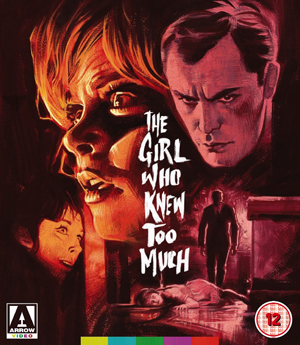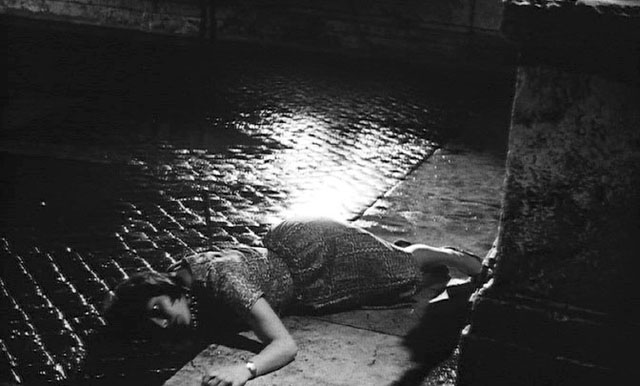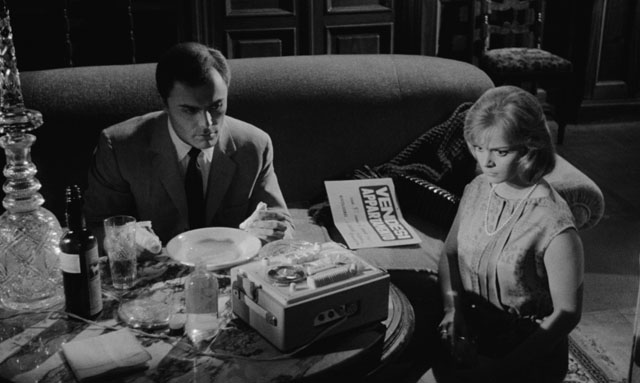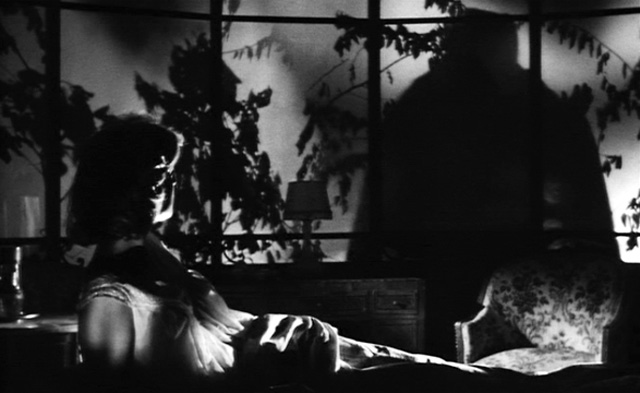 Considered to be the first true Giallo thriller committed to celluloid and cheekily swiping its name from Hitchcock’s The Man Who Knew Too Much this was a 1963 black and white film from Italian auteur Mario Bava and one that paved the way for countless directors in his homeland to imitate, the peak of which came thick and fast in the 70’s and 80’s. Bava had made his mark with the excellent gothic horror film Black Sunday in 1960 and quickly established himself as a narrator of lurid crime films in this somewhat new style based on popular pulp fiction murder mystery thrillers, whose bright yellow covers led to the term giallo itself. In the film the books themselves are cited as being somewhat dangerous and trashy reading that are responsible for all sorts of reprehensible behaviour and indeed our main character in the film Nora Davis (Letícia Román) who is reading one on the plane to visit Rome has promised her family that she will give up reading these somewhat dubious titles. Naturally as soon as the plane lands she is pretty much embroiled in the mysteries straight out of one of the books she so loves.
Considered to be the first true Giallo thriller committed to celluloid and cheekily swiping its name from Hitchcock’s The Man Who Knew Too Much this was a 1963 black and white film from Italian auteur Mario Bava and one that paved the way for countless directors in his homeland to imitate, the peak of which came thick and fast in the 70’s and 80’s. Bava had made his mark with the excellent gothic horror film Black Sunday in 1960 and quickly established himself as a narrator of lurid crime films in this somewhat new style based on popular pulp fiction murder mystery thrillers, whose bright yellow covers led to the term giallo itself. In the film the books themselves are cited as being somewhat dangerous and trashy reading that are responsible for all sorts of reprehensible behaviour and indeed our main character in the film Nora Davis (Letícia Román) who is reading one on the plane to visit Rome has promised her family that she will give up reading these somewhat dubious titles. Naturally as soon as the plane lands she is pretty much embroiled in the mysteries straight out of one of the books she so loves.
No sooner has she visited her aunt, the old (somewhat dotty cat) lady snuffs it of natural causes and in a fashion that reminds of a similar death in Bava’s horror compendium Black Sabbath made the same year. Running for help Nora is mugged by an atypical stripped shirt robber and knocked out in an austere Roman square, coming to she thinks she witnesses a murder before passing out again. Naturally on being found nobody really believes her apart from a besotted love interest Dr. Marcello Bassi played by a very youthful John Saxon who would later go on to star in Dario Argento’s seminal giallo Tenebrae (1982). There are so many references in this film to later giallos you can practically tick them off as the plot develops. For a start it appears that murders are being committed in an alphabetical order with A, B and C having met their doom and naturally enough Nora’s surname is Davis. This would not be the last time an alphabet killer would be unleashed.’ Even a scene with an old style lift going up and down in a tense part seems as though it could well have paved the way for Argento to utilise for grizzly death in Profondo Rosso (1975) or perhaps I was reading too much into this.
One things for certain, the sleuthing heroine in danger with her sidekick love struck suitor is a narrative device that would crop up time and time again. Bava seemed to think perhaps as this was such a new sub-genre of film style that the audience may need some help with the plot and narrative and provides a talk over part in the film which I found highly unnecessary and off putting. It really does illustrate that the director was finding his feet here and comes across as somewhat clunky compared to other films he would later direct in the style. The Girl.. still has plenty about it to delight from the cloak and dagger mystery and set ups along with the requisite cast of red herrings and numerous twists and turns to put the viewer off the scent of the killer.
Filmed in the early 60’s it is very much a restrained feature considering how the genre would develop into really grizzly death and mayhem in the future, indeed Bava himself helped hit the nadir of debauchery with his gory opus A Bay Of Blood (1971). It’s evident that the sixties are not quite swinging yet and the freedom of the 70’s are quite some way off here. There’s a huge sense of propriety with the amorous courting going on and male, female characterisation is certainly a bit in the stone age. I guess that gives the film a certain charm and it’s one that is looked upon fondly by genre enthusiasts today over 50 years after its release. Stylistically there are flashes of brilliance within Bava’s cinematography and scene set up. For instance a shot of a huge Gothic building reflected in a puddle and dissolving in the rain and another of a plain white decorated corridor with long trailing light fittings with bare bulbs swinging in an unexpected breeze, literally jump off the screen at you. Naturally the music is synonymous of the time and although not a fantastically memorable score, it’s one that adds to the tension and suspense and there is plenty of that in the film. Bava does a great job here and keeps the thrills and spills coming and I found myself on the edge of the seat due to the quick plotting and the compact running time of the film. It did probably help as I had not actually seen this before, this never came out on UK video to the best of my knowledge and I had never caught it on DVD. It’s also a film that will definitely be worthy of repeated viewings and historically it is an essential movie for anyone with a passing interest in the Italian giallo genre.
Naturally it, as other Bava features, got crude treatment by the Americans who released it in a tampered form retitling it ‘Evil Eye’ which is frankly rather daft. They also changed the music, added humour (the film was not without it in a subtle fashion in the first place) and lost a slightly contentious plot device. Arrow have with their 3 disc Blu-Ray, DVD presentation included both versions of the film so you are free to compare and contrast and see which you prefer. As with Rabid Dogs and Lisa And The Devil though I am sure there are not too many fans of the alternative cut.
There’s a good selection of extras including a commentary track again by Bava enthusiast Tim Lucas and an introduction by the always knowledgeable Alan Jones. A 20 minute look back at the film and Bava’s work also has Jones fondly reminiscing about things along with Italian director Luigi Cozzi whose The Killer Must Kill Again (1975) was a standout slice of giallo, Richard Stanley (Hardware, Dust Devil) and writer Mikel Koven. Everyone is in agreement about just how important Bava’s work was and even if it is “a little rough around the edges” this somewhat understated film compared to some of his other’s is a highly enjoyable film and one that spearheaded a movement. Whereas Letícia Román pretty much disappeared from acting in the late 60’s John Saxon is a screen stalwart accruing close to 200 credits. There is a short look back at his time working on The Girl.. which occurred just after his Universal contract run out and interestingly was spurred on after he received a call from Letícia Román suggesting him for the part. Sharp, witty and insightful he has a great recollection of the time spent on the movie and has plenty of interesting anecdotes too.
In a way it’s a shame that Giallo films died out and went out of style. Argento certainly kept things going and no doubt should have quit while he was ahead with Opera (1988). His most recent piece actually entitled ‘Giallo’ (2009) was a real test for long suffering viewers and quite honestly the final nail in the coffin for these creative and fascinating films. ‘The Girl Who Knew Too Much’ might not be the greatest example but it is the one that started it all and is well worth watching now. As ever Arrow have come up trumps giving UK viewers the chance to see this film in all its glory, the black and white cinematography literally sparkles off the screen here making it all the more sumptuous and it’s a movie well worth looking back on five decades later.
(Pete Woods)




Leave a Reply